A Comparative Analysis of Canadian Immigration Policies and Reforms
VerifiedAdded on 2022/08/12
|7
|1246
|18
Essay
AI Summary
This essay examines the evolution of Canadian immigration policies, particularly focusing on the Point Based System (PBS) introduced in 1976, and compares it with the US immigration policies. The paper discusses the shift from prioritizing European migrants to a system designed to attract skilled labor, driven by economic needs and globalization. It analyzes the shortcomings of the PBS, highlighting issues with its assessment criteria, such as the emphasis on age and education, and their impact on immigrant selection. The essay also touches upon the influence of international relations and migration diplomacy, providing insights into the effectiveness of the Canadian immigration policies in meeting the demands of the labor market and the challenges faced in assessing immigrant applications.
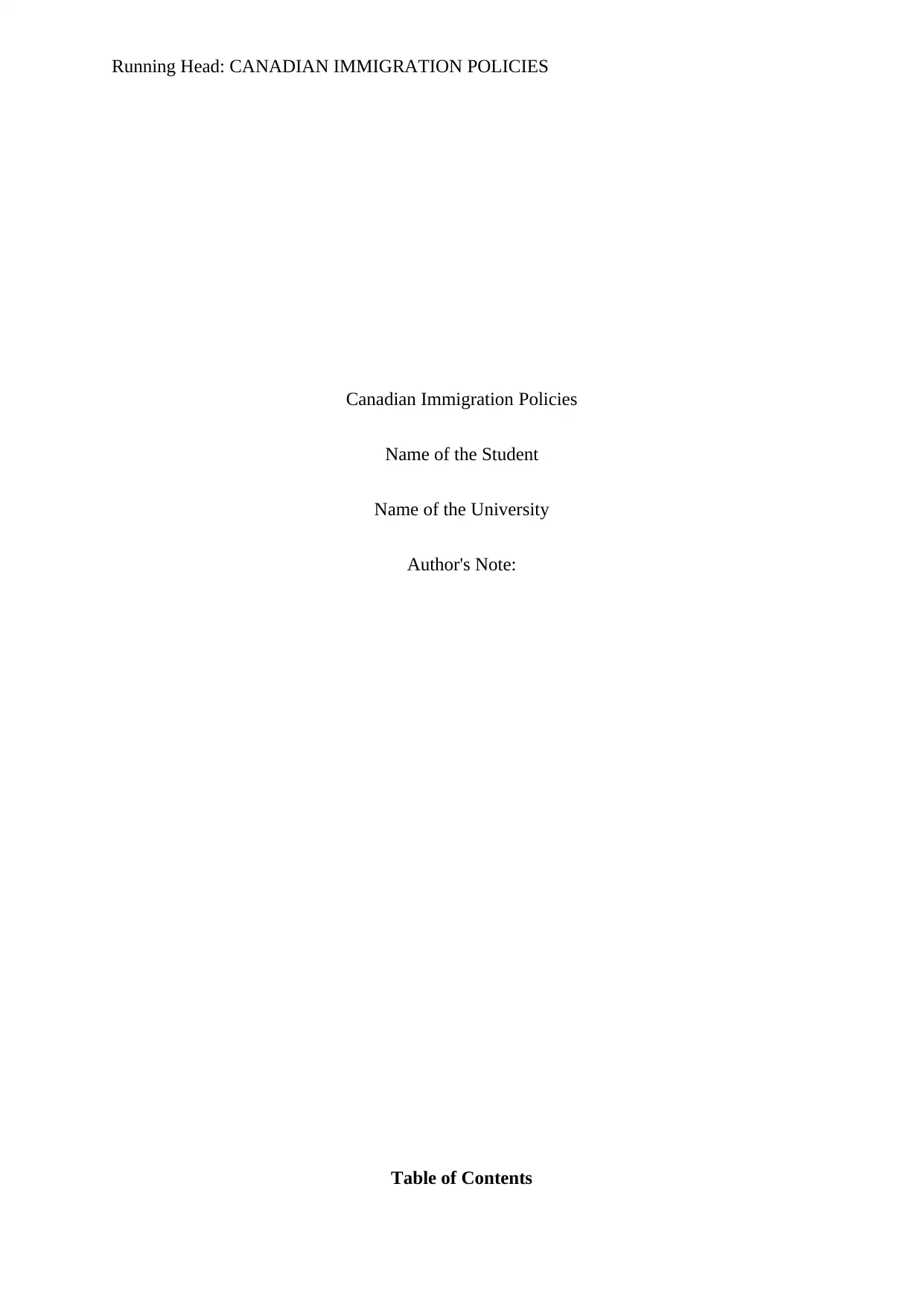
Running Head: CANADIAN IMMIGRATION POLICIES
Canadian Immigration Policies
Name of the Student
Name of the University
Author's Note:
Table of Contents
Canadian Immigration Policies
Name of the Student
Name of the University
Author's Note:
Table of Contents
Paraphrase This Document
Need a fresh take? Get an instant paraphrase of this document with our AI Paraphraser
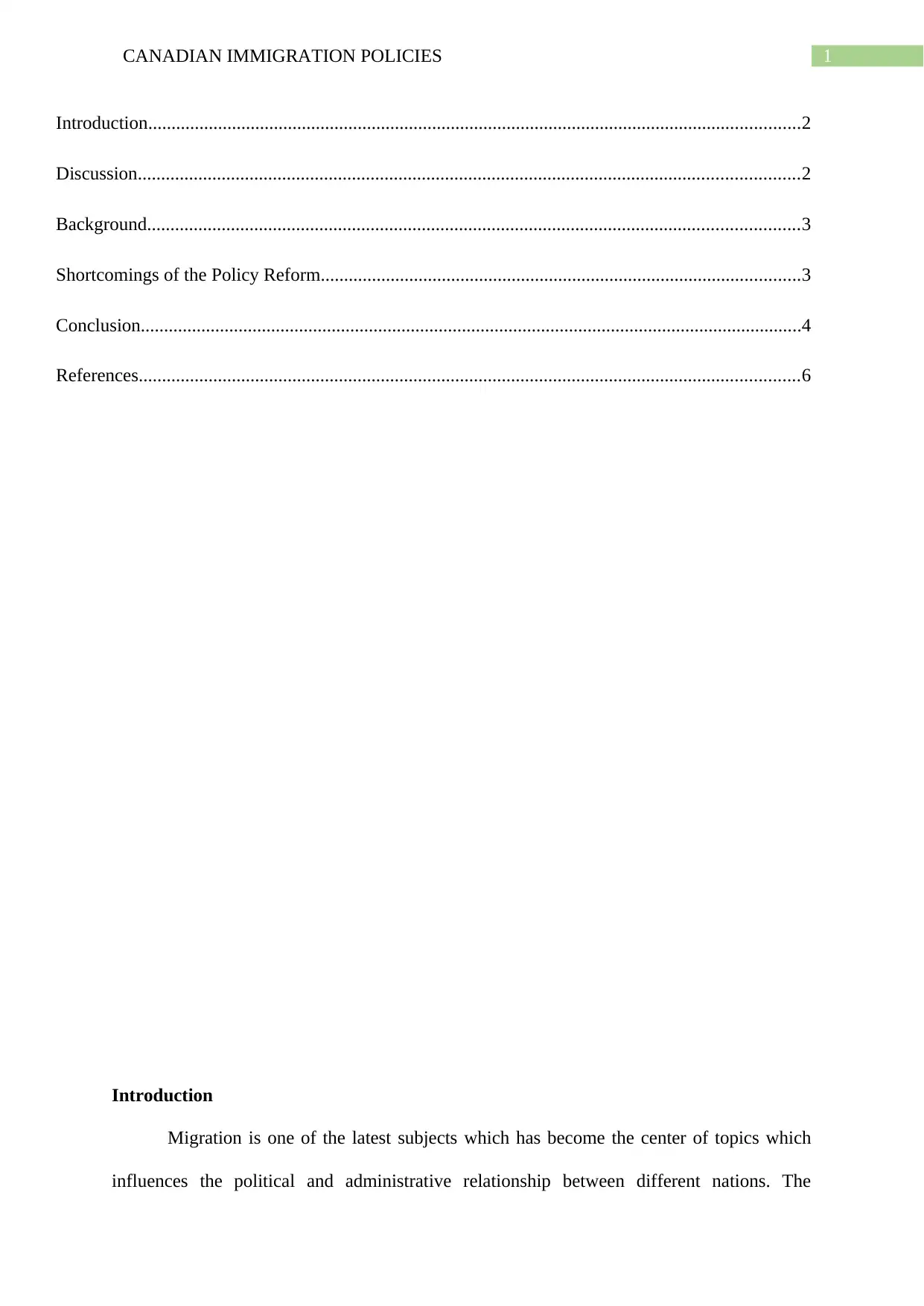
1CANADIAN IMMIGRATION POLICIES
Introduction............................................................................................................................................2
Discussion..............................................................................................................................................2
Background............................................................................................................................................3
Shortcomings of the Policy Reform.......................................................................................................3
Conclusion..............................................................................................................................................4
References..............................................................................................................................................6
Introduction
Migration is one of the latest subjects which has become the center of topics which
influences the political and administrative relationship between different nations. The
Introduction............................................................................................................................................2
Discussion..............................................................................................................................................2
Background............................................................................................................................................3
Shortcomings of the Policy Reform.......................................................................................................3
Conclusion..............................................................................................................................................4
References..............................................................................................................................................6
Introduction
Migration is one of the latest subjects which has become the center of topics which
influences the political and administrative relationship between different nations. The
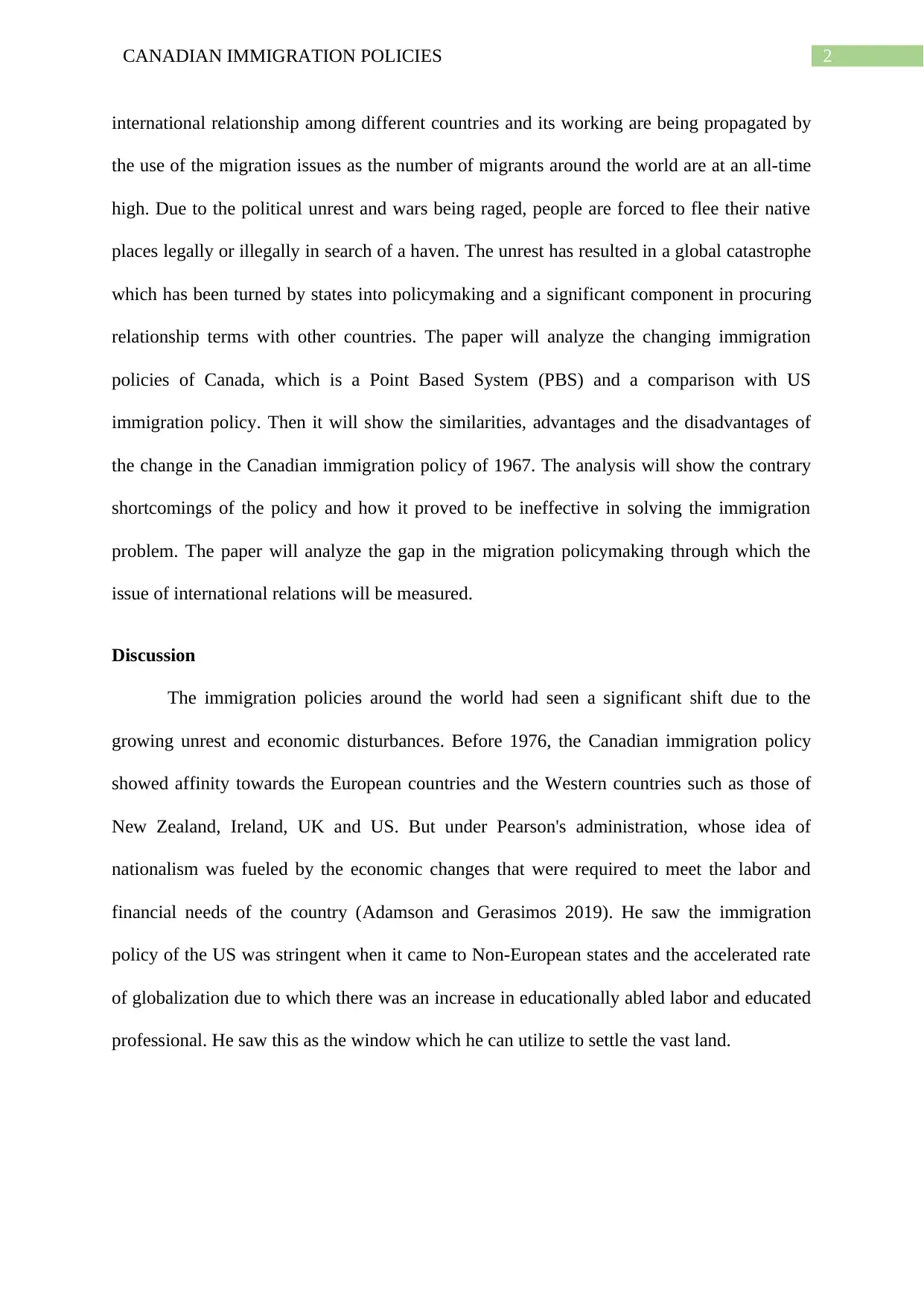
2CANADIAN IMMIGRATION POLICIES
international relationship among different countries and its working are being propagated by
the use of the migration issues as the number of migrants around the world are at an all-time
high. Due to the political unrest and wars being raged, people are forced to flee their native
places legally or illegally in search of a haven. The unrest has resulted in a global catastrophe
which has been turned by states into policymaking and a significant component in procuring
relationship terms with other countries. The paper will analyze the changing immigration
policies of Canada, which is a Point Based System (PBS) and a comparison with US
immigration policy. Then it will show the similarities, advantages and the disadvantages of
the change in the Canadian immigration policy of 1967. The analysis will show the contrary
shortcomings of the policy and how it proved to be ineffective in solving the immigration
problem. The paper will analyze the gap in the migration policymaking through which the
issue of international relations will be measured.
Discussion
The immigration policies around the world had seen a significant shift due to the
growing unrest and economic disturbances. Before 1976, the Canadian immigration policy
showed affinity towards the European countries and the Western countries such as those of
New Zealand, Ireland, UK and US. But under Pearson's administration, whose idea of
nationalism was fueled by the economic changes that were required to meet the labor and
financial needs of the country (Adamson and Gerasimos 2019). He saw the immigration
policy of the US was stringent when it came to Non-European states and the accelerated rate
of globalization due to which there was an increase in educationally abled labor and educated
professional. He saw this as the window which he can utilize to settle the vast land.
international relationship among different countries and its working are being propagated by
the use of the migration issues as the number of migrants around the world are at an all-time
high. Due to the political unrest and wars being raged, people are forced to flee their native
places legally or illegally in search of a haven. The unrest has resulted in a global catastrophe
which has been turned by states into policymaking and a significant component in procuring
relationship terms with other countries. The paper will analyze the changing immigration
policies of Canada, which is a Point Based System (PBS) and a comparison with US
immigration policy. Then it will show the similarities, advantages and the disadvantages of
the change in the Canadian immigration policy of 1967. The analysis will show the contrary
shortcomings of the policy and how it proved to be ineffective in solving the immigration
problem. The paper will analyze the gap in the migration policymaking through which the
issue of international relations will be measured.
Discussion
The immigration policies around the world had seen a significant shift due to the
growing unrest and economic disturbances. Before 1976, the Canadian immigration policy
showed affinity towards the European countries and the Western countries such as those of
New Zealand, Ireland, UK and US. But under Pearson's administration, whose idea of
nationalism was fueled by the economic changes that were required to meet the labor and
financial needs of the country (Adamson and Gerasimos 2019). He saw the immigration
policy of the US was stringent when it came to Non-European states and the accelerated rate
of globalization due to which there was an increase in educationally abled labor and educated
professional. He saw this as the window which he can utilize to settle the vast land.
⊘ This is a preview!⊘
Do you want full access?
Subscribe today to unlock all pages.

Trusted by 1+ million students worldwide
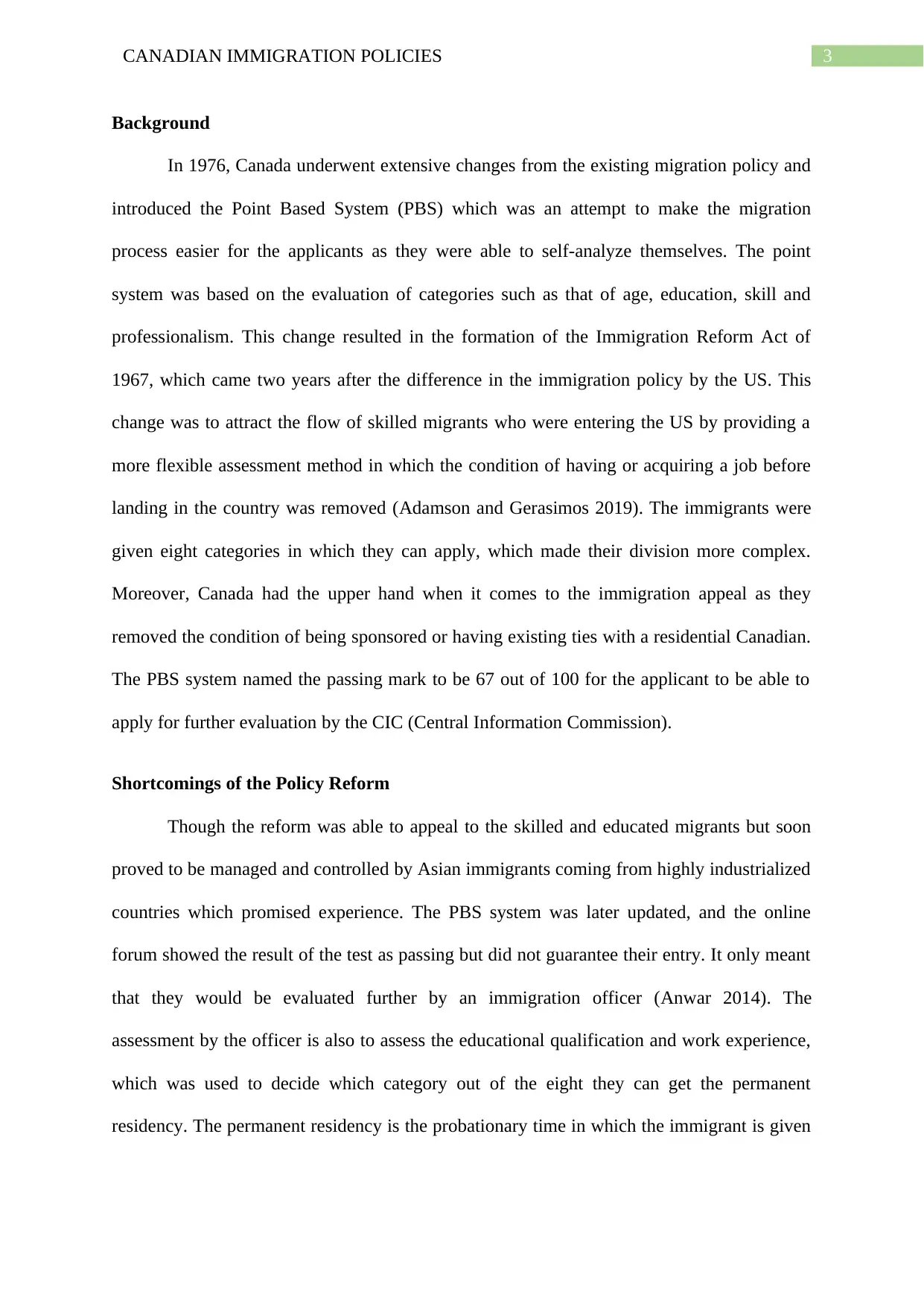
3CANADIAN IMMIGRATION POLICIES
Background
In 1976, Canada underwent extensive changes from the existing migration policy and
introduced the Point Based System (PBS) which was an attempt to make the migration
process easier for the applicants as they were able to self-analyze themselves. The point
system was based on the evaluation of categories such as that of age, education, skill and
professionalism. This change resulted in the formation of the Immigration Reform Act of
1967, which came two years after the difference in the immigration policy by the US. This
change was to attract the flow of skilled migrants who were entering the US by providing a
more flexible assessment method in which the condition of having or acquiring a job before
landing in the country was removed (Adamson and Gerasimos 2019). The immigrants were
given eight categories in which they can apply, which made their division more complex.
Moreover, Canada had the upper hand when it comes to the immigration appeal as they
removed the condition of being sponsored or having existing ties with a residential Canadian.
The PBS system named the passing mark to be 67 out of 100 for the applicant to be able to
apply for further evaluation by the CIC (Central Information Commission).
Shortcomings of the Policy Reform
Though the reform was able to appeal to the skilled and educated migrants but soon
proved to be managed and controlled by Asian immigrants coming from highly industrialized
countries which promised experience. The PBS system was later updated, and the online
forum showed the result of the test as passing but did not guarantee their entry. It only meant
that they would be evaluated further by an immigration officer (Anwar 2014). The
assessment by the officer is also to assess the educational qualification and work experience,
which was used to decide which category out of the eight they can get the permanent
residency. The permanent residency is the probationary time in which the immigrant is given
Background
In 1976, Canada underwent extensive changes from the existing migration policy and
introduced the Point Based System (PBS) which was an attempt to make the migration
process easier for the applicants as they were able to self-analyze themselves. The point
system was based on the evaluation of categories such as that of age, education, skill and
professionalism. This change resulted in the formation of the Immigration Reform Act of
1967, which came two years after the difference in the immigration policy by the US. This
change was to attract the flow of skilled migrants who were entering the US by providing a
more flexible assessment method in which the condition of having or acquiring a job before
landing in the country was removed (Adamson and Gerasimos 2019). The immigrants were
given eight categories in which they can apply, which made their division more complex.
Moreover, Canada had the upper hand when it comes to the immigration appeal as they
removed the condition of being sponsored or having existing ties with a residential Canadian.
The PBS system named the passing mark to be 67 out of 100 for the applicant to be able to
apply for further evaluation by the CIC (Central Information Commission).
Shortcomings of the Policy Reform
Though the reform was able to appeal to the skilled and educated migrants but soon
proved to be managed and controlled by Asian immigrants coming from highly industrialized
countries which promised experience. The PBS system was later updated, and the online
forum showed the result of the test as passing but did not guarantee their entry. It only meant
that they would be evaluated further by an immigration officer (Anwar 2014). The
assessment by the officer is also to assess the educational qualification and work experience,
which was used to decide which category out of the eight they can get the permanent
residency. The permanent residency is the probationary time in which the immigrant is given
Paraphrase This Document
Need a fresh take? Get an instant paraphrase of this document with our AI Paraphraser
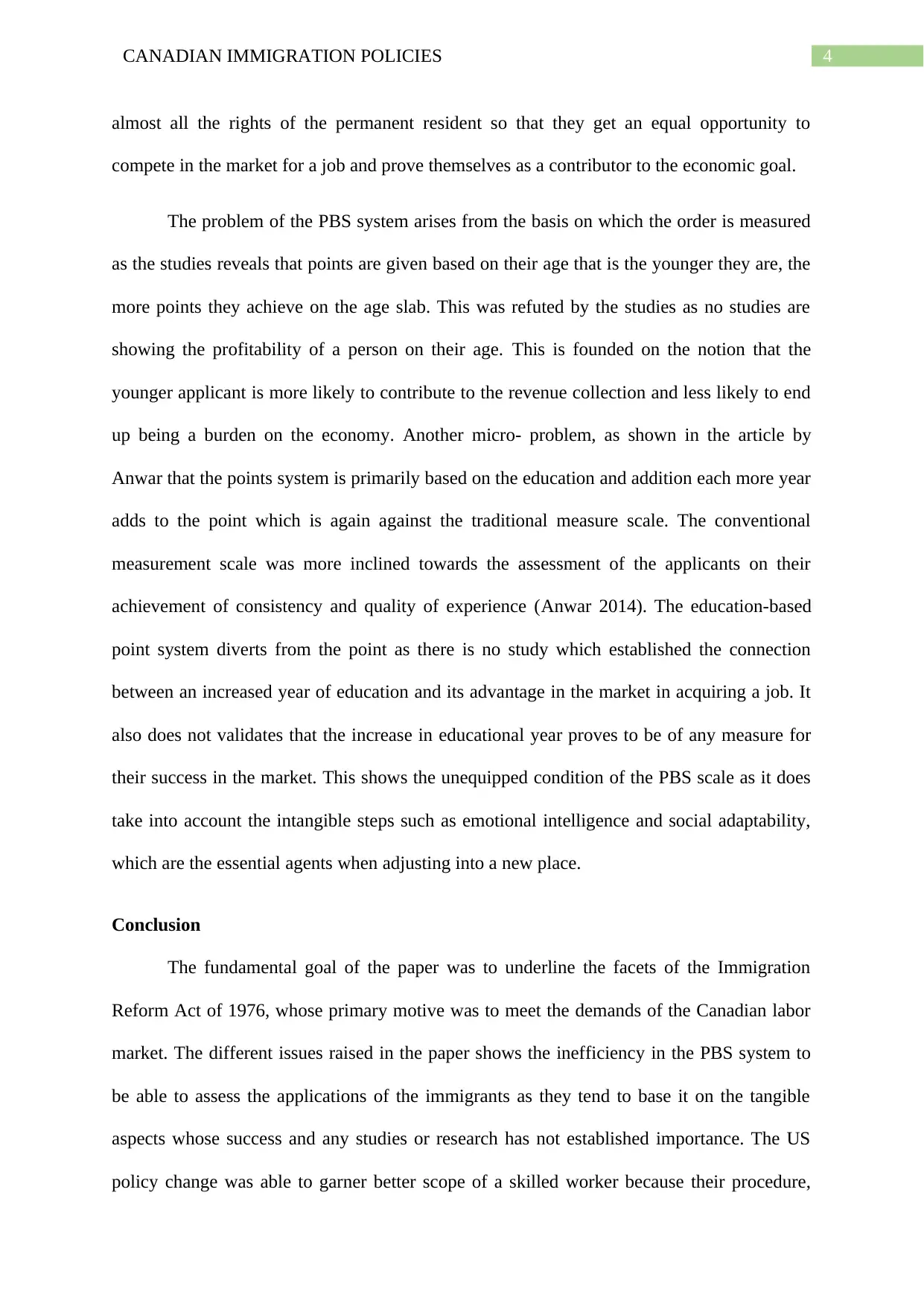
4CANADIAN IMMIGRATION POLICIES
almost all the rights of the permanent resident so that they get an equal opportunity to
compete in the market for a job and prove themselves as a contributor to the economic goal.
The problem of the PBS system arises from the basis on which the order is measured
as the studies reveals that points are given based on their age that is the younger they are, the
more points they achieve on the age slab. This was refuted by the studies as no studies are
showing the profitability of a person on their age. This is founded on the notion that the
younger applicant is more likely to contribute to the revenue collection and less likely to end
up being a burden on the economy. Another micro- problem, as shown in the article by
Anwar that the points system is primarily based on the education and addition each more year
adds to the point which is again against the traditional measure scale. The conventional
measurement scale was more inclined towards the assessment of the applicants on their
achievement of consistency and quality of experience (Anwar 2014). The education-based
point system diverts from the point as there is no study which established the connection
between an increased year of education and its advantage in the market in acquiring a job. It
also does not validates that the increase in educational year proves to be of any measure for
their success in the market. This shows the unequipped condition of the PBS scale as it does
take into account the intangible steps such as emotional intelligence and social adaptability,
which are the essential agents when adjusting into a new place.
Conclusion
The fundamental goal of the paper was to underline the facets of the Immigration
Reform Act of 1976, whose primary motive was to meet the demands of the Canadian labor
market. The different issues raised in the paper shows the inefficiency in the PBS system to
be able to assess the applications of the immigrants as they tend to base it on the tangible
aspects whose success and any studies or research has not established importance. The US
policy change was able to garner better scope of a skilled worker because their procedure,
almost all the rights of the permanent resident so that they get an equal opportunity to
compete in the market for a job and prove themselves as a contributor to the economic goal.
The problem of the PBS system arises from the basis on which the order is measured
as the studies reveals that points are given based on their age that is the younger they are, the
more points they achieve on the age slab. This was refuted by the studies as no studies are
showing the profitability of a person on their age. This is founded on the notion that the
younger applicant is more likely to contribute to the revenue collection and less likely to end
up being a burden on the economy. Another micro- problem, as shown in the article by
Anwar that the points system is primarily based on the education and addition each more year
adds to the point which is again against the traditional measure scale. The conventional
measurement scale was more inclined towards the assessment of the applicants on their
achievement of consistency and quality of experience (Anwar 2014). The education-based
point system diverts from the point as there is no study which established the connection
between an increased year of education and its advantage in the market in acquiring a job. It
also does not validates that the increase in educational year proves to be of any measure for
their success in the market. This shows the unequipped condition of the PBS scale as it does
take into account the intangible steps such as emotional intelligence and social adaptability,
which are the essential agents when adjusting into a new place.
Conclusion
The fundamental goal of the paper was to underline the facets of the Immigration
Reform Act of 1976, whose primary motive was to meet the demands of the Canadian labor
market. The different issues raised in the paper shows the inefficiency in the PBS system to
be able to assess the applications of the immigrants as they tend to base it on the tangible
aspects whose success and any studies or research has not established importance. The US
policy change was able to garner better scope of a skilled worker because their procedure,
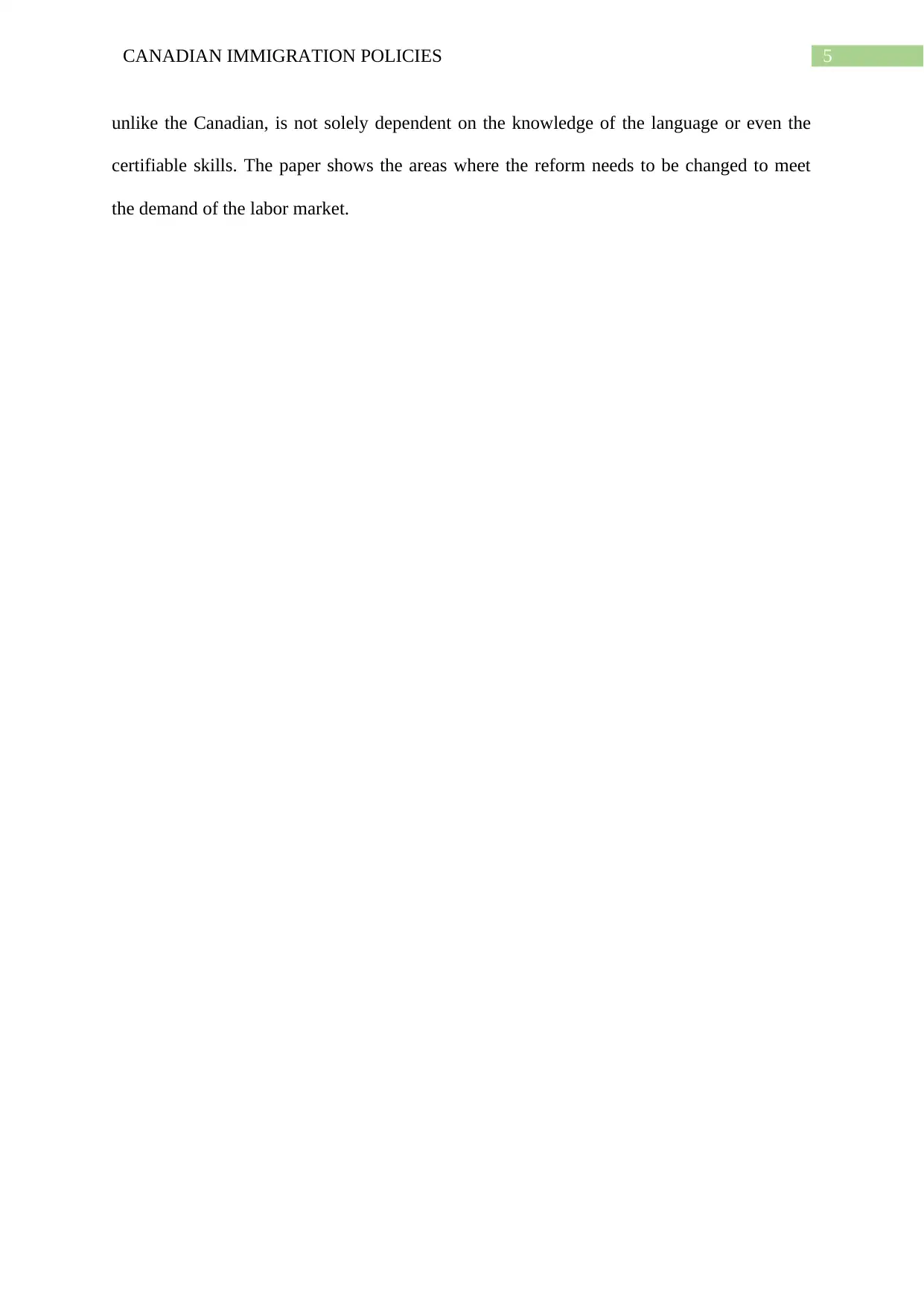
5CANADIAN IMMIGRATION POLICIES
unlike the Canadian, is not solely dependent on the knowledge of the language or even the
certifiable skills. The paper shows the areas where the reform needs to be changed to meet
the demand of the labor market.
unlike the Canadian, is not solely dependent on the knowledge of the language or even the
certifiable skills. The paper shows the areas where the reform needs to be changed to meet
the demand of the labor market.
⊘ This is a preview!⊘
Do you want full access?
Subscribe today to unlock all pages.

Trusted by 1+ million students worldwide
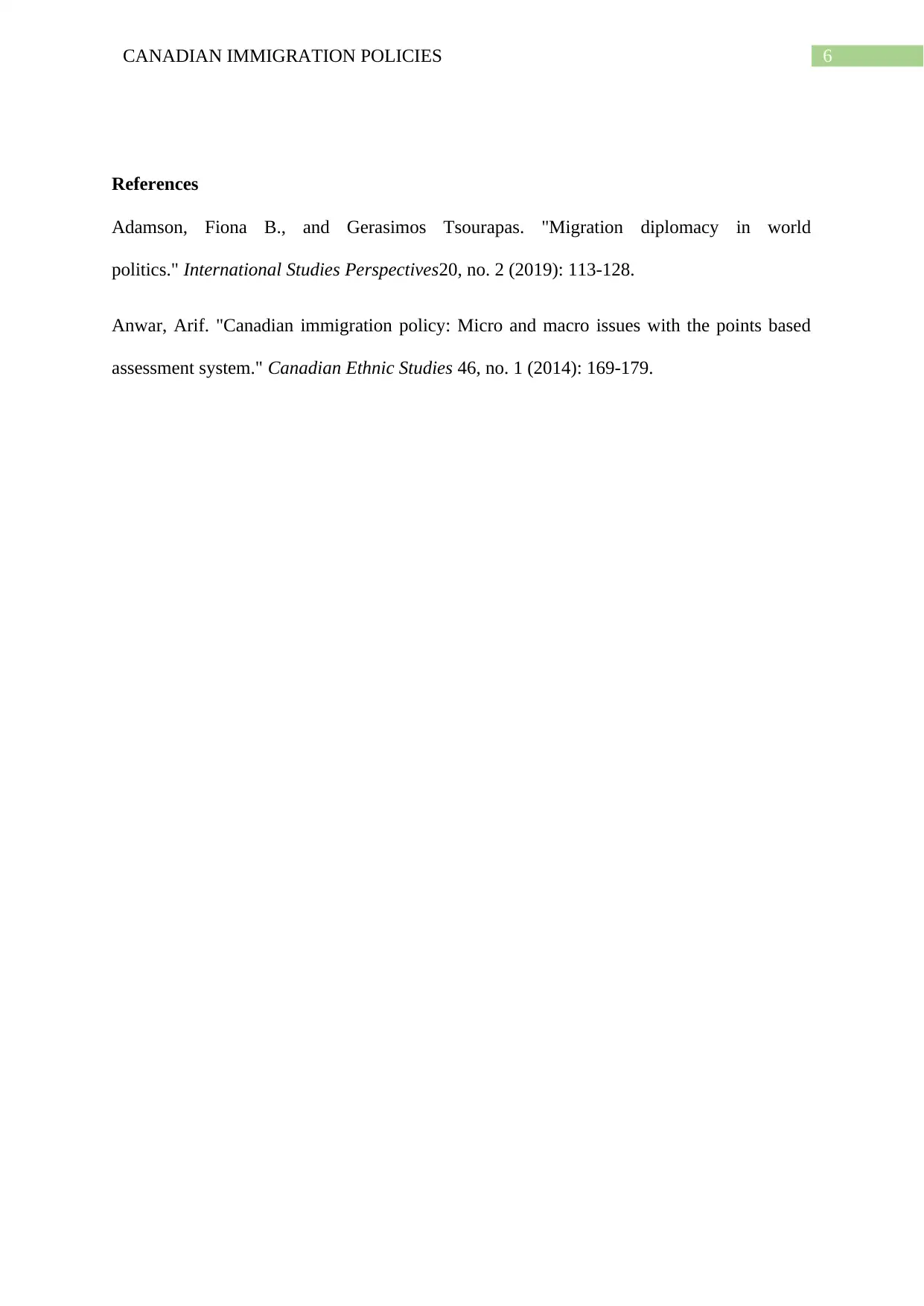
6CANADIAN IMMIGRATION POLICIES
References
Adamson, Fiona B., and Gerasimos Tsourapas. "Migration diplomacy in world
politics." International Studies Perspectives20, no. 2 (2019): 113-128.
Anwar, Arif. "Canadian immigration policy: Micro and macro issues with the points based
assessment system." Canadian Ethnic Studies 46, no. 1 (2014): 169-179.
References
Adamson, Fiona B., and Gerasimos Tsourapas. "Migration diplomacy in world
politics." International Studies Perspectives20, no. 2 (2019): 113-128.
Anwar, Arif. "Canadian immigration policy: Micro and macro issues with the points based
assessment system." Canadian Ethnic Studies 46, no. 1 (2014): 169-179.
1 out of 7
Related Documents
Your All-in-One AI-Powered Toolkit for Academic Success.
+13062052269
info@desklib.com
Available 24*7 on WhatsApp / Email
![[object Object]](/_next/static/media/star-bottom.7253800d.svg)
Unlock your academic potential
Copyright © 2020–2025 A2Z Services. All Rights Reserved. Developed and managed by ZUCOL.



